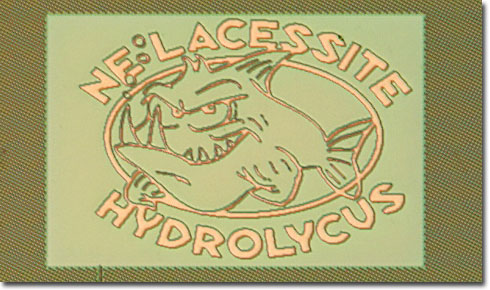Hydrolycus (Brightfield Illumination)
|
Encircling a silicon rendition of the predatory South American Payara sport fish is the text "Ne lacessite Hydrolycus", which loosely translates to "Do not aggravate Hydrolycus" or even more loosely to "Don't Mess With Payara". The warning message was placed on a Hewlett-Packard PA-8700 RISC microprocessor by engineer Chris Woody, who is a chip designer in the Fort Collins (Colorado) Microelectronics Laboratory. The advanced chip was made on a 0.18-micrometer SOI (Silicon-on-Insulator) process with a 7-layer copper interconnect. The name of this microprocessor (Payara) is part of a recent trend to name Hewlett-Packard PA-RISC (Precision Architecture Reduced Instruct Set Computer) projects after predatory fish. View this silicon artwork under differential interference contrast and darkfield illumination. The Amazon River basin of South America is home to the infamous piranhas, enormous anacondas, and graceful, freshwater pink dolphins. Also found exclusively in this area is the payara (Hydrolycus scomberoides), a large and frightful-appearing fish species. Legendary as the vampire fish of the Amazon, this ferocious, silver game fish draws anglers from around the world to the Amazon and Orinoco Rivers of Venezuela, Brazil, Bolivia, Guyana, and Peru. In the genus Hydrolycus, there are four scientifically described species. The maximum length of the payara is reported at 117 centimeters (46 inches) and the highest recorded weight is 18 kilograms (39.7 pounds). As a tropical fish, H. scomberoides prefers water temperatures between 24 and 28 degrees Celsius. The payara is a game fish, but is only of minor commercial fishery importance. Tarpon-like acrobatics and line-stripping runs, which rival big bonefish, make the hard-fighting payara a favorite for sports anglers fishing Brazil's Xingu River. The payara (also known as the water wolf) is a carnivore, being mostly a ichthyophagus (fish eater), as are its meat-eating cousins, the piranhas (Serrasalmo). In fact, experienced fishing guides use live piranhas as bait for these fish, which are nicknamed the "vampires of the Amazon" because of the two fang-like teeth erupting from their lower jaw. Known as the peixe-cachorra (dogfish) in Brazil, and chambira in Peru, these toothy predators prefer fast-moving waters and tend to concentrate around rocky rapids. In pet stores, small specimens are marketed to tropical fish enthusiasts as "vampire tetras". Other monikers of the payara include the giant wolf fish, Dracula fish, vampire fish, and saber-toothed dogfish. |
© 1995-2022 by Michael W. Davidson and The Florida State University. All Rights Reserved. No images, graphics, software, scripts, or applets may be reproduced or used in any manner without permission from the copyright holders. Use of this website means you agree to all of the Legal Terms and Conditions set forth by the owners.
This website is maintained by our
|
